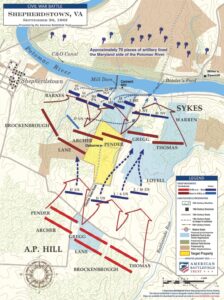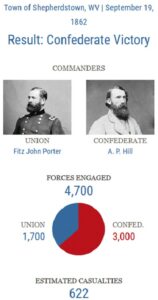The Battle of Shepherdstown…NOT the Battle of Antietam
Hi – Janet from Shepherdstown Mystery Walks here. DO NOT mistake the massive Battle of Antietam with the Battle of Shepherdstown. It’s very easy to do, and the history here is somewhat confusing. But, I’m here to set the score straight.
The Battle of Antietam was the single bloodiest day of battle in all of US History, on US soil. In one 12-hour period, there were 23,000 casualties. Yes, I said TWENTY THREE THOUSAND. It devastated Sharpsburg, Maryland, which is 2-miles from Shepherdstown, as the crow flies. Shepherdstown was absolutely untouched from this major battle. Then, two days later…
It was after midnight on September 20, 1862, not much more than 48 hours after the firing ended on the deadliest day of the Civil War, the Battle of Antietam. After that fighting of September 17, the armies eyed each other warily before the Confederates began to slip across the Potomac back into Virginia after dusk on the 18th. The retreat was a gloomy echo of their jubilant crossing into Maryland a couple of weeks before, when high-spirited Rebel soldiers were cheered by the strains of bands playing ‘Maryland, My Maryland.’ Cavalrymen posted in the river held torches to light the gloom as the long column of wagons, ambulances, guns and weary foot soldiers splashed across Boteler’s Ford on their way into the relative safety of the Old Dominion.
Boteler’s Ford was a mile and a half downstream from Shepherdstown, a town in the part of the Old Dominion that in June 1863 would be carved off as the new Union state of West Virginia. Also called Blackford’s Ford and Pack Horse Ford, the spot had been a crossing since colonial times. When the water level was down, the stony shelf of the ford was clearly visible, but it was ‘deep and rocky’ during the retreat.
On September 18, After an exhausting day of battle, General Robert E. Lee settled into a much-needed sleep under an apple tree. It was not long before he awakened to a real-life nightmare. Brigadier General William Nelson Pendleton, who served as the Army of Northern Virginia’s chief of artillery, stood over him in a near panic with terrible news. The army’s entire rear guard, with 44 pieces of artillery, had just been overwhelmed and gobbled up by Major General George B. McClellan’s Army of the Potomac at the Potomac River crossing of Boteler’s Ford. ‘All?’ asked Lee. The shaken Pendleton replied, ‘Yes, General, I fear all.’
Here’s the backstory:
After the fighting of the 17th, Pendleton had pulled together 44 cannons to form an artillery reserve to protect the vital crossing point on the Potomac. He managed to place 33 of the weapons in positions bearing on the ford, but there were no good firing positions for the remaining 11, so they were sent to the rear to await a possible call to the front. While the number of guns seemed formidable, and included eight Parrott rifles and a long-range Whitworth, Pendleton’s hodgepodge of cannons also consisted of several short-range howitzers and a dozen obsolete 6-pounders that would be of little use against longer-range Federal rifled guns. Brigadier Generals Lewis Armistead’s and Alexander Lawton’s two battered and understrength infantry brigades supported the gunners. Pendleton posted most of the infantry along the riverbank, instructing them to stay concealed and not to fire unnecessarily.
What happened was, while Lee was relaxing from the horrors of Antietam, Porter pushed elements of two divisions across the river to establish a bridgehead. General A.P. Hill’s division counterattacked while many of the Federals were crossing the Potomac river, inflicting heavy casualties. Porter pulled back to the Union side of the river. This rearguard battle discouraged Federal pursuit of Robert E. Lee’s defeated army back to Virginia and ended Lee’s Maryland Campaign. On November 7, President Lincoln relieved McClellan of command for not aggressively pursuing Lee’s retreating army.

The Battle of Shepherdstown was the last bloodshed of the 1862 Maryland campaign. The minor disaster convinced McClellan that caution should be the byword when pursuing Lee’s army. His Union forces reoccupied Harpers Ferry but went no farther, and the Federal general seemed content with reports from his signal posts that the Army of Northern Virginia was remaining static.
Come out to Shepherdstown and soak all this in. Antietam is only 2 miles away – both are amazing places to visit. Hear more on this battle, and more, on a Shepherdstown Mysteries Walk tour.

